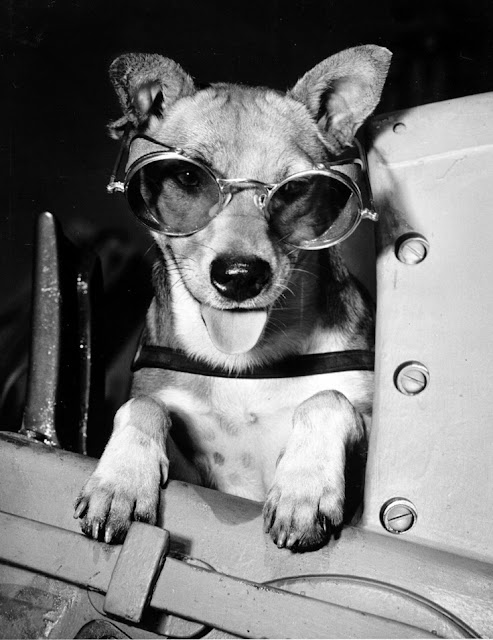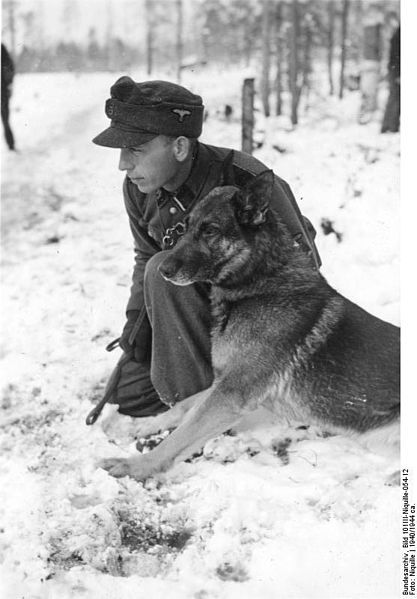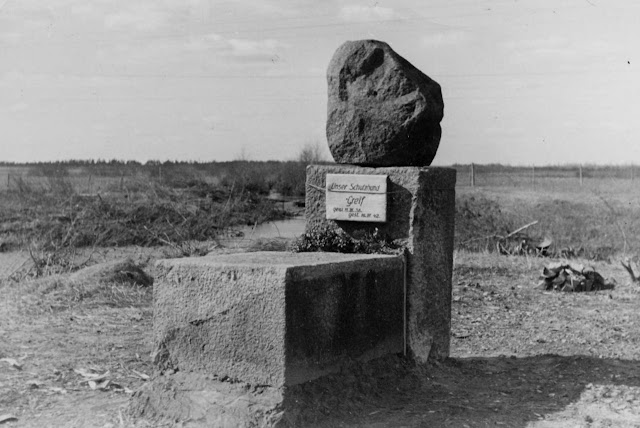Canines of Valor

We have a page devoted to cats in World War II, so it only seemed appropriate to include one for dogs who participated in World War II as well. They weren't all just along for the ride - though, some of them were.
Dogs served in numerous capacities in the war. The one above parachuted with his mates, the one below carried ammunition.
In fact, some dogs received military decorations.
More commonly, though, dogs assisted with mundane tasks such as beach patrol.
And solitary sentry duty.
Big dogs helped to guard the big guns.
Dogs chowed down with the men in the field.
Sometimes, the men wished they were treated as well as dogs.
Some of the dogs were quite beautiful.
Extensive training went into making sure that dogs helped the war effort. In fact, in a strange tale, dogs were responsible for a US Army military formation. After Pearl Harbor, Japanese-Americans in Hawaii were used by the US Army to help train dogs. The Japanese-Americans were dressed in Imperial Japanese uniforms in order to train the dogs to hunt them. Later, these same second-generation Japanese-Americans were formed into the 442nd Regimental Combat Unit and sent to fight the Germans in Italy in 1944.
But when they followed proper procedure, the dogs could survive just about anything.
Dogs went where their master went. Sometimes, they handled the conditions much better than them.
There was a program called "Dogs for Defense" during World War II. Bet you didn't know that. Kids willingly donated their pets for use by the military. Don't know if they ever got them back. But, the dogs did their duty.
Dogs were often heroic and were used to sweep for mines, as in the picture of Russians in Tilsit, below.
Dogs went into the field with their masters.
German Shepherds were used for many purposes during the Third Reich.
Even fighter pilots need love. Below, Adolf Galland, replete in a pressurized suit and flight coat, plays with his dog "Schweinebauch" ("Pork belly") at his posting at the Stab.1/JG.26 farmhouse headquarters in Audembert, Pas de Calais, France, 1940 (colorized).
Dogs also were used to carry bombs and run under tanks. The Soviets came up with this idea. While only used for a short time, it led German tankers consistently to gun down any dogs they could see throughout the war, to the bewilderment of bystanders.
 |
| A Soviet bomb-carrying dog on his last run. |
Speaking of bombs, let's remember the famous dog immortalized in "The Dam Busters" (1955). Wing commander Guy Gibson (below with pipe, and hands-on his personal pet) made him the 617 Squadron mascot. The beautiful black lab perished in action when hit by a car the night before the famous raid on Germany's Ruhr Dams, 16–17 May 1943. The lab's grave is at RAF Scampton, Lincolnshire, and there are reports that his ghost has been seen around RAF Scampton and the Dambusters Memorial at Woodhall Spa. He may be looking for the ghost of his commander, who also died on a mission not long afterward.
 |
| Guy Gibson and his mates with their black lab. |
Dogs also were used to carry medical supplies. Man's best friend!
Of course, dogs were used for guard duty, too.
The dogs looked fierce and had big bites. You wouldn't want to be on the receiving end of a dog trained to kill.
 |
| An SS officer with his dog next to a camouflaged SdKfz 222 armored car. |
To a dog, he's just out for a walk. Nice to get out of the kennel and stretch your legs on a long walk. He doesn't really care what his master has in mind. And his doggy friends are out with him, too!
But even the fiercest German Shepherds could be friendly and gentle with children.
Dogs can't pick their masters. The dog above was Hitler's pet German Shepherd, and the little girl is Helga Goebbels. Neither survived the war.
Hitler's dog Blondi is well known: Her master tested his cyanide capsules out on Blondi right before he used one himself. Did you know, though, that Hitler actually had two dogs? The other was named Bella. Bella doesn't get a lot of press, and nobody seems to know what happened to her. Incidentally, they were both German Shepherds. What, you expected Mr. Master Race to own Irish Wolfhounds or Chihuahuas?
The dog above did survive the war. Sadly, his master didn't. Fala became a celebrity and even has his own Wikipedia page and two statues.
Do you recognize the little girl in the picture above? I thought you might. She didn't survive the war, either. I don't know about the dog.
Dogs also had to survive rough environments along with everybody else.
 |
| Lieutenant General Walter Hahm, Commander of the 260th Infantry Division at the Division Command post in Uspech, Russia in May 1943 |
Dogs came ashore with many Pacific invasions, sometimes with the first wave.
Dogs also were helping the Japanese, too. Dogs don't pick sides.
 |
| A dog attacking a victim of the Holocaust. |
Above are some highly decorated dogs.
The Luftwaffe pilot above didn't take his dog on missions... most likely. It is Major Kurt Bühligen, Geschwaderkommodore of the Jagdgeschwader 2 'Richthofen.' But he could have; Bühligen was a Big Dog and could do what he liked on his missions.
The dog above, though, did fly into combat. Antis was the mascot and Czech airman Robert Bozdech was his owner. Yes, a dog flew into combat on an RAF mission. Strictly against regulations, but where there's a bark, there's a way!
To be fair about things, the above photo shows that P-51 pilots liked their dogs, too.
Australian soldiers, in particular, liked their dogs and even gave them special uniforms.
Many units had dogs as mascots who went everywhere the soldiers went.
Dogs helped out the Military Police, too.
Dogs actually parachuted into combat, and that involved a lot of preparation.
But mostly, dogs were just there at the base for downtime relaxation.
The two dogs above had just been promoted. Look how happy they are!
The RAF pilot above loved his dog.
The Russian soldiers above let their dog snuggle with them.
Above is the most decorated dog of World War II. He got to march in a parade.
The dog above looks like just the right size to be carried around.
Dogs would fall in line and come to attention just like their masters.
Sometimes the dogs found cozy spots to rest in.
Sailors always have loved dogs who inspired, well, dogged determination. How much you want to bet that the one above was named either "Winston" or "Churchill"?
I don't know if the bulldog above is the same as the previous one, but this one's name is Venus and he runs the HMS Vansittart here in 1941.
Smaller dogs were hand because they could fit into backpacks and such. You know you're treasured when your master adds you to his 20 kg pack.
 |
| A Soldier of the 535th Anti-Aircraft Artillery Battalion, 99th Infantry Division, with his pup during the Battle of the Bulge, somewhere in Belgium on 4th January 1945. |
 |
| Both sides used dogs for companionship during the Battle of the Bulge. (Nigulla, Federal Archive). |
Coast Guard dogs got dressed up just like their masters, as with "Salty" in 1943, above.
Some dogs liked to imitate their masters. Or is it the other way around? Imitation is the highest form of flattery.
Dogs sometimes died of one thing or another at a young age due to the war. This caused their owners much pain. One fellow went all out and built a monument to his deceased friend.
 |
| German dog grave in the USSR. The inscription states, "Our watchdog Greif ("Cross"), 11.09.38-16.04.42." The photo was taken on the territory of the Soviet Union, spring 1942. |
HonestPaws.com.
2020























































